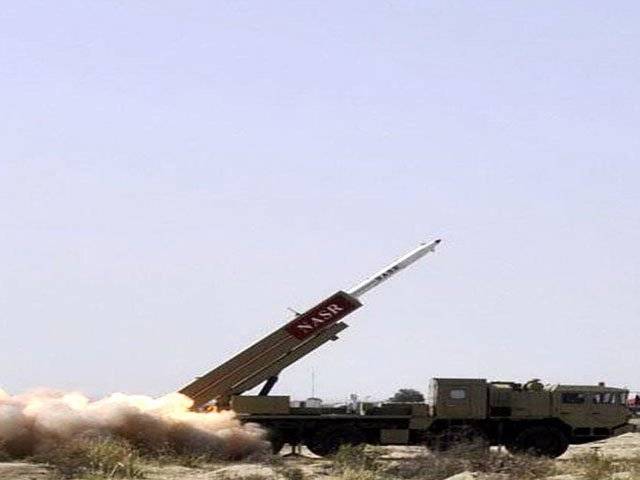ISLAMABAD - Pakistan on Tuesday successfully conducted the first flight test of the newly-developed short range surface-to-surface Multi-Tube Ballistic Missile Hatf IX (NASR). According to ISPR, the missile has been developed to add deterrence value to Pakistans strategic weapons development programme at shorter ranges. The NASR, with a range of 60 km, carries nuclear warheads of appropriate yield with high accuracy, shoot and scoot attributes. This quick response system addresses the need to deter evolving threats. The test was witnessed by Director General Strategic Plans Division, Lieutenant General (r) Khalid Ahmed Kidwai, Chairman NESCOM Irfan Burney, senior officers from the strategic forces, scientists and engineers of strategic organisations. On this occasion, Director General Strategic Plans Division Lieutenant General (r) Khalid Ahmed Kidwai said the test was a very important milestone in consolidating Pakistans strategic deterrence capability at all levels of the threat spectrum. He said in that hierarchy of military operations, the NASR weapon system now provided Pakistan with short-range missile capability in addition to the already available medium and long-range ballistic missiles and cruise missiles in its inventory. The president and the prime minister, who congratulated the scientists and engineers on their outstanding success, also warmly appreciated the successful test. Meanwhile, CEO of Islamabad-based Strategic Technology Resources (STR), Dr Shireen M Mazari while commenting on testing of the missile described it a welcome development for Pakistan as it will bolster its nuclear deterrence. In a press release she said the STR had predicted some months back that it was time Pakistan tested some short-range missiles to counter Indias doctrine of cold start and other formulations to counter the nuclear deterrence presently prevalent in South Asia. She opined that with successful test fire of this short-range arsenal, Pakistan had now acquired tactical nuclear capability as a deterrent against potential of mechanised conventional land forces by India. She pointed out that this was essential in the wake of Indias adventurous war-fighting doctrine formulations, which envisaged the use of rapid deployment of armed brigades and divisions in surprise and rapid attacks. She noted India had always felt that Pakistan had a loophole in terms of lacking short-range battlefield nuclear weapons, which it could exploit on the assumption that it made little sense for Pakistan to respond to such conventional attacks with strategic nuclear weapons. Now with the NASR Pakistan had plugged that loophole, she said, adding the Indian dreams of a limited war against Pakistan through its cold start strategy had been laid to rest. The Nasr test also shows the successful miniaturisation Pakistan has achieved which in itself is a creditable technological achievement. Once again, the STR would like to reiterate that with the development of this multi-tube, 'shoot-n-scoot nuclear delivery capability, the Indian planners would now be deterred from considering options of limited war. This will allow for a reassertion of a stable nuclear deterrence in the region, she concluded.
Tuesday, May 14, 2024
Hatf IX test-fired

Dar holds key meetings in China to enhance coop
May 14, 2024
Pakistan, US vow to counter ISIS-Khorasan, TTP
May 14, 2024
On the quality of education system
May 14, 2024
Time Is Now
May 14, 2024
Power Abuse
May 14, 2024
PTI’s Agenda
May 14, 2024
Indigenous Armaments
May 13, 2024
The Path Ahead
May 13, 2024
Political Instability
May 14, 2024
Justice Denied
May 14, 2024
Pakistan’s Ticking Time Bomb
May 14, 2024
The Burden of Loans and Interest
May 14, 2024
Higher Education System Challenges
May 14, 2024
ePaper - Nawaiwaqt
Advertisement
Nawaiwaqt Group | Copyright © 2024





